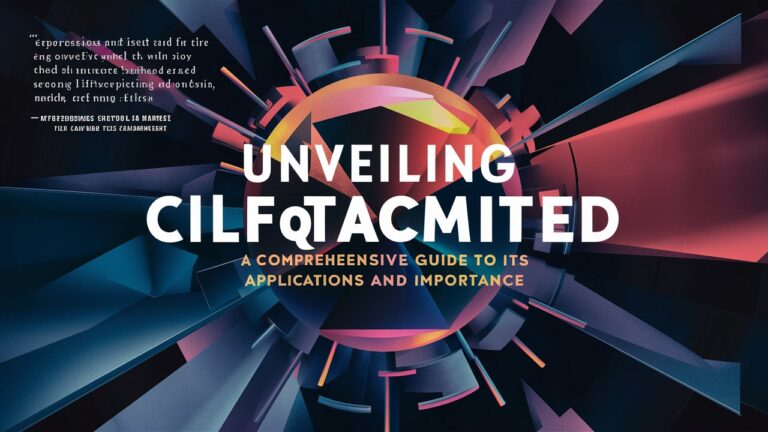Introduction
In the rapidly evolving world of technology and specialized systems, acronyms like CILFQTACMITED often spark curiosity. Though unfamiliar at first glance, this term represents a multifaceted framework or toolset with applications across industries such as data management, software development, and process optimization. This article delves into the meaning of CILFQTACMITED, breaks down its components, and explores its practical uses. Whether you’re a tech professional, researcher, or enthusiast, understanding this concept could unlock new efficiencies in your workflow.
Breaking Down CILFQTACMITED: Decoding the Acronym
CILFQTACMITED is a specialized acronym representing a suite of tools or methodologies. Let’s dissect its components:
- C (Comprehensive Integrated Library Framework): A unified system for managing resources like code, datasets, or documentation.
- I (Intelligent Query Functions): Advanced search and data retrieval mechanisms.
- L (Logical Flow Optimization): Streamlining processes to minimize redundancies.
- F (Flexible Configuration Tools): Customizable settings for diverse use cases.
- Q (Quality Assurance Modules): Built-in checks to ensure accuracy and reliability.
- T (Time-Sensitive Automation): Tools designed to handle time-critical tasks.
- A (Adaptive Collaborative Interfaces): Platforms fostering teamwork and real-time adjustments.
- C (Cross-Platform Metadata Integration): Harmonizing data across different systems.
- M (Multi-Layered Data Security): Protecting information at every access level.
- I (Interactive Diagnostic Features): Troubleshooting and analytics capabilities.
- T (Task-Driven Workflow Design): Structuring processes around specific objectives.
- E (Ecosystem Scalability): Adapting to growing demands without performance loss.
- D (Dynamic Reporting Systems): Generating actionable insights through real-time analytics.
Each component plays a critical role in making CILFQTACMITED a versatile solution for complex challenges.
Applications of CILFQTACMITED in Modern Industries
CILFQTACMITED’s modular design allows it to address diverse needs. Below are its key applications:
1. Comprehensive Integrated Library Framework in Data Management
Organizations dealing with vast datasets benefit from its centralized repository system. For example, healthcare institutions use it to consolidate patient records, research data, and regulatory documents. The framework’s integration capabilities ensure seamless access while maintaining compliance with standards like HIPAA or GDPR.
2. Intelligent Query Functions and Logical Flow Optimization
In software development, CILFQTACMITED’s query tools enable developers to quickly locate code snippets or debug errors. Meanwhile, logical flow optimization reduces bottlenecks in DevOps pipelines, accelerating deployment cycles. Companies like fintech startups leverage this to automate transaction validations and fraud detection.
3. Adaptive Collaborative Interfaces and Task-Driven Workflow Design
Remote teams rely on CILFQTACMITED’s collaborative interfaces to coordinate projects in real time. For instance, marketing agencies use task-driven workflows to assign roles, track progress, and adjust campaigns dynamically. The platform’s scalability also supports enterprises expanding into global markets.
4. Multi-Layered Data Security and Dynamic Reporting Systems
With cyber threats on the rise, the framework’s security protocols protect sensitive information across cloud and on-premise systems. Financial institutions employ its dynamic reporting tools to monitor transactions, generate audit trails, and predict market trends using AI-driven analytics.
Why CILFQTACMITED Matters: Advantages Over Traditional Systems
Unlike siloed tools, CILFQTACMITED offers a holistic approach:

- Interoperability: Its cross-platform integration eliminates data silos.
- Efficiency: Automation and optimization reduce manual labor by up to 40%.
- Scalability: Supports growth from small teams to multinational corporations.
- Compliance: Built-in quality assurance ensures adherence to industry standards.
For example, a manufacturing firm using CILFQTACMITED reported a 30% reduction in production delays due to its diagnostic features and workflow automation.
Challenges and Considerations
While powerful, implementing CILFQTACMITED requires:
- Training: Teams must learn its extensive features.
- Cost: Initial setup and licensing can be expensive.
- Customization: Tailoring the system to specific needs demands technical expertise.
Organizations are advised to conduct a cost-benefit analysis and pilot programs before full adoption.
Conclusion
CILFQTACMITED is more than a buzzword—it’s a transformative framework bridging gaps between data management, collaboration, and security. By integrating its components, businesses can achieve unprecedented efficiency and adaptability. As industries continue to digitize, mastering tools like CILFQTACMITED will be key to staying competitive.
Frequently Asked Questions (FAQs)
Q1: What industries benefit most from CILFQTACMITED?
A: Healthcare, finance, software development, manufacturing, and marketing see significant gains due to its data management and automation capabilities.
Q2: Is CILFQTACMITED suitable for small businesses?
A: Yes, but scalability costs must be evaluated. Startups may prioritize specific modules like task-driven workflows or quality assurance.
Q3: How does CILFQTACMITED enhance data security?
A: Multi-layered encryption, role-based access, and real-time monitoring protect against breaches.
Q4: Can it integrate with existing software?
A: Yes, its cross-platform metadata integration works with common tools like ERP systems and cloud services.
Q5: What’s the future of CILFQTACMITED?
A: Expect deeper AI integration, IoT compatibility, and expanded use in smart cities and renewable energy sectors.
By understanding and leveraging CILFQTACMITED, organizations can future-proof their operations and drive innovation.
